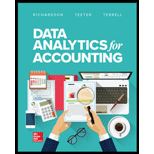
Identify where the analytical techniques cannot be implemented by the individuals building teams.
Answer to Problem 1MCQ
Option c.
Explanation of Solution
Under the guidance of the chief audit executive (CAE) or another manager, these individuals build teams to develop and implement analytical techniques to aid the following audits:
- Process efficiency and effectiveness.
- Governance, risk, and compliance, including internal controls effectiveness.
- Information technology and information systems audits.
- Forensic audits in the case of fraud.
- Support for the financial statement audit.
Justification for correct and incorrect answer:
a.
This is not the correct choice as these individuals build teams to develop and implement analytical techniques to aid all of the following audits except tax compliance.
b.
This option is an incorrect option because all these factors are included in the audits which are aided by the individuals who build teams to develop and implement analytical techniques.
c.
Under the guidance of the Chief Audit Executive (CAE) or another manager, these individuals build teams to develop and implement analytical techniques to aid all of the following audits except tax compliance. Thus, this option is correct.
d.
This is an incorrect option because these individuals build teams to develop and implement analytical techniques to aid all of the following audits except tax compliance and support for the financial statement audit.
Want to see more full solutions like this?
Chapter 5 Solutions
Data Analytics For Accounting
- I am trying to find the accurate solution to this general accounting problem with appropriate explanations.arrow_forwardIn December 2018, Crescent Fabrication established its predetermined overhead rate for jobs produced during 2019 using the following cost estimates: overhead cost of $300,000 and direct materials cost of $250,000. Determine the predetermined overhead rate for 2019. Helparrow_forwardAnswer this below Questionarrow_forward
- Need Answerarrow_forwardOn January 1, 20X1, Pinnatek Inc., which uses the straight-line method, purchases a machine for $72,000 that it expects to last for 12 years; Pinnatek expects the machine to have a residual value of $6,000. What is the annual depreciation rate? a. 9.7% b. 11.5% c. 12.5% d. 6.25% e. 7.64% helparrow_forwardWhat was it's P/E ratio ?arrow_forward
- Determine the predetermined overhead rate for 2019arrow_forwardNeed answerarrow_forwardCalculate the depreciation for Year 1 using the units-of-production (activity-based) depreciation method. 40 service trucks were purchased at a cost of $38,000 each. Each truck is estimated to be driven a total of 80,000 miles and then be sold for an estimated $8,000. In Year 1, the trucks were driven 1,120,000 miles. HELP me with thisarrow_forward
- Accurate Answerarrow_forwardA machine has a cost of $18,500, an estimated residual value of $4,500, and an estimated useful life of five years. The machine is being depreciated on a straight-line basis. At the end of the second year, what amount will be reported for accumulated depreciation? Answerarrow_forwardHelp me with thisarrow_forward
 Auditing: A Risk Based-Approach (MindTap Course L...AccountingISBN:9781337619455Author:Karla M Johnstone, Audrey A. Gramling, Larry E. RittenbergPublisher:Cengage Learning
Auditing: A Risk Based-Approach (MindTap Course L...AccountingISBN:9781337619455Author:Karla M Johnstone, Audrey A. Gramling, Larry E. RittenbergPublisher:Cengage Learning Auditing: A Risk Based-Approach to Conducting a Q...AccountingISBN:9781305080577Author:Karla M Johnstone, Audrey A. Gramling, Larry E. RittenbergPublisher:South-Western College Pub
Auditing: A Risk Based-Approach to Conducting a Q...AccountingISBN:9781305080577Author:Karla M Johnstone, Audrey A. Gramling, Larry E. RittenbergPublisher:South-Western College Pub


